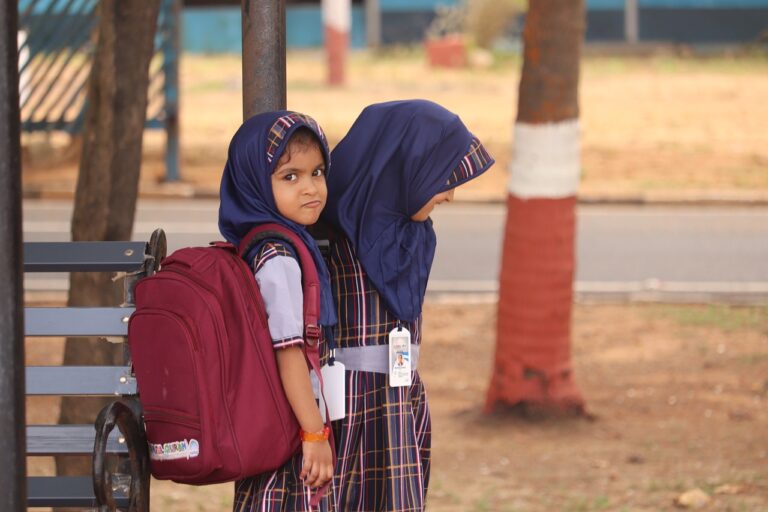
In Denmark, the government has blocked a bill to ban the hijab in primary schools. The veil for girls and women of the Islamic religion is a distinctive sign of the choice of adherence to faith. The origin and above all its direct link with the indications of the Prophet are controversial, in fact the Koran does not specifically mention the obligation of the veil but generically invites women to modesty: Sura XXIV in fact establishes:
Tell the believers to lower their eyes and keep their shame and not show too much their beautiful parts, except what appears from the outside, and cover their breasts with a veil and not show their beautiful parts to anyone other than their husbands or their fathers.
It is worn starting from the age of puberty, i.e. between the ages of 9 and 12, as it indicates the maturity reached in order to be able to make an informed choice of faith. It shouldn’t be an obligation, like all the practices and rites of a religion, but only the result of a responsible, free and conscious choice. It is a symbol of religious devotion and is worn as an act of Sharia observance.
In reality, there are different types and styles of veil: from the burqa, which totally covers the head and face, to the hijab, which covers the head and neck leaving the face completely uncovered, the chador, which only covers the shoulders and the top of the head, finally the niqāb, typical of Saudi Arabia, which completely covers the female figure but leaves the eyes visible.
In some countries with a Muslim majority it is compulsory to wear it. In Iran since 1983 a law requires all women to wear the hjiab, as well as in Tunisia and Turkey. In Saudi Arabia and Afghanistan, the burqa is mandatory.
On the other hand, the headscarf has become the subject of debate in some Western countries, sometimes giving rise to tensions and clashes between the defenders of the headscarf, as a sign of identity and cultural and religious belonging, and the defenders of freedom of choice and not to bind a certain type of dress deemed disrespectful of the dignity and freedom of women.
We must go back to 2011 for a first judgment of the European Court of Human Rights (EDU) concerning the Islamic veil in Dahlab v. Switzerland (European Court of Human Rights, application n. 42393/9, Dahlab v. Switzerland, 2001, available here: http://hudoc.echr.coe.int/eng?i=001-22643). Since then, several and numerous causes have been addressed regarding the freedom or otherwise to wear the veil.
Thus, while in Austria a law was approved in 2019 that prevents primary school girls from wearing the hijab in class, the Danish government recently rejected a bill proposed by the Danish People’s Party which wanted to prevent girls from wearing the hijab in class, partly going against the recommendations of a parliamentary commission which had indicated the veil as one of the tools that create discrimination in the Danish female population.
Does the veil as an element and symbol of distinction or of belonging to a religion in the name of freedom? It is an issue that arises in various countries and which questions its meaning for women and society as a whole.
Read more: https://iqna.ir/it/news/3488729/danimarca-governo-rifiuta-piano-per-vietare-hijab-nelle-scuole
This problem is also frequent in various other European countries, such as in France, where the very strong and rigid lay tradition has frequently sparked debates. The last episode told concerns the fashion of wearing traditional clothes linked to one’s religion, in particular the Islamic one. Thus “in French high schools Islamic clothing is predominant. Veil, abaya (traditional Islamic dress for women) and kamis (Muslim tunic for men) characterize the new Parisian fashion”, as revealed by the 2022 survey by L’Opinion. Here the article: https://lanuovabq.it/it/islam-in-francia-il-velo-a-scuola-diventa-una-moda
Similar episodes are also reported in non-EU countries. In India, in 2022 “the state of Karnataka banned the wearing of the hijab during lessons, requiring girls to deprive themselves of their identity and exacerbating social tensions between Hindus and Muslims, which were followed by weeks of protest”. The debate is open and very heated also in the Indian subcontinent.
Read more: https://ecointernazionale.com/2022/02/lindia-divieto-indossare-velo-nelle-scuole-publiche/
In Iran last April the Minister of Education confirmed the validity of the law that prohibits those who do not wear the headscarf from attending school. The need for girls to wear a religious dress to access education is confirmed in a very clear and rigid way, to comply with the prescriptions of Islam and sharia.